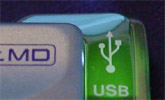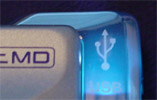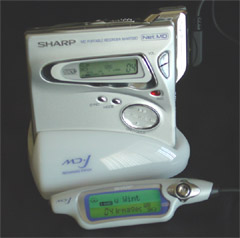|
|
Sharp's initial NetMD Offering
In the world of MiniDisc, there are two popular names when it comes to portable recorders: Sony and Sharp. The Sony MZ-N1 and the Sharp IM-MT880 are the flagship models for the two respective companies, and were both released at roughly the same time in Japan (mid-December 2001). The Sharp IM-MT880 is a half-generation follow-up to the MD-MT770, which was released just four months prior (August 2001). At first glance, the MT770 and MT880 appear to be nearly identical, and the only significant difference between the two is (of course) the added NetMD functionality on the MT880. If you're not up-to-date on MD news, NetMD is a protocol that allows songs to be downloaded from PC to MD at high-speed (ie, faster than realtime).
While Sony seems to put more of its emphasis on providing features that make music listening more convenient (things like separate treble and bass controls, personal disc memory, melody time alarms, and a jog dial for easy track navigation), Sharp traditionally puts its emphasis on providing features to please those that use MD primarily for recording on-the-go. Specifically, some of the MT880's features include the ability to change recording levels during recording without the hassle of fighting a menu; synchro-start and auto-pause recording functions for the line and mic inputs; higher-quality mic preamp than any recent Sony unit; quick (i.e., less than one second) motor response to |<< and >>| operations; and the ability to start recording from the remote. If you do a lot of microphone recording (whether it be live music, interviews, dictations, or even environmental sounds), you may want to look for a Sharp portable (such as the MT880). However if you don't plan on doing any live music/microphone recording with your MD, and plan on recording most of your music from CD's and MP3's, then a Sony unit (such as the MZ-N1) may look more attractive to you.
Sharp's first NetMD portable, the IM-MT880
Personally I was a bit skeptical of the MT770/880 when I first saw their announcements, as you may immediately notice that the main unit has been stripped of the text display and a number of the buttons, making the remote control necessary for a number of operations. However when I first started playing with the MT880, I found it to be a very nice little unit, which -- if you don't mind carrying the remote around with you -- can give the Sony MZ-N1 a run for its buck.
The Sharp IM-MT880 (left) and the Sony MZ-N1 (right)
A few quick things you should know...
On paper, the Sharp MT880 appears to have some glaring disadvantages when compared directly to the Sony N1. However if you can get past these inconveniences, you'll find that the MT880 has some great features that are sure to be appreciated by MD recording enthusiasts. To touch on some of the things that I found amiss with the MT880:
- NetMD downloads only run at half the speed as on the MZ-N1 (0.9x SP, 8x LP2, 16x LP4);
- There is no text/time display on the MT880's main unit;
- A number of functions - including BASS and EDIT functions - cannot be accessed without the remote;
- There is no jog dial on the Sharp for easy track navigation;
- The MT880's battery life is significantly shorter than the Sony N1's batterylife (28+ hours playback on the N1 vs 9.5 hours on the MT880, according to the manufacturer's specs).
The discreptancy in battery life is particularly interesting since both units use the same battery (1.2V 1400mAh Nickel Metal Hydride rechargeable); however Sony has been known to exaggerate their battery life figures much more than Sharp (the N1's "28-30 hours" is probably closer to 20), so the discreptancy is not as large as it looks on paper.
The MT880 with the attached AA battery case
In any case, the 9.5 hours of playback is not terrible (although it's not great either by today's standards), and the extra juice used by the MT880 goes towards the stronger headphone output and the faster response time of the optical pick-up, among other things. By adding on the external AA battery pack, you can push the battery life up to an adequate 24 hours of playback/14 hours of recording.
Sharp MT880
Battery Life
|
NiMH
(playback / recording)
|
AA battery
(playback / recording)
|
NiMH + AA
(playback / recording)
|
SP:
(stereo or mono)
|
9.5 hrs
|
6 hrs
|
14 hrs
|
6 hrs
|
24 hrs
|
14.5 hrs
|
|
LP2:
|
11 hrs
|
8.5 hrs
|
17.5 hrs
|
9.5 hrs
|
29.5 hrs
|
20.5 hrs
|
|
LP4:
|
12.5 hrs
|
10 hrs
|
19.5 hrs
|
12.5 hrs
|
33 hrs
|
26 hrs
|
Sharp IM-MT880 battery life figures from the user manual
Controls • User Interface
Close-up of the MT880's control pad and face buttons
Sharp has significantly reduced the number of buttons on the main unit, leaving only the SYNC, MODE, RECORD, and VOLUME buttons on the main unit (and despite its appearance, the clear red RECORD button does NOT light up during recording as the Sony N1's record switch does), along with the 4-directional oval-shaped control pad. The design of the 4-directional control pad on the main body of the MT880 is far superior to the Sony N1's control bar (and is also superior to the R909's circular control pad). The N1's control mechanism has a very loose feel, and requires the user to push the bar straight in to begin playback. With the amount of play that the control bar gives, this is often very difficult to do without accidentally pressing in one of the four directions instead, making the general controls rather frustrating. Meanwhile the MT880's control pad has a very tight feel to it, and doesn't require the user to push it straight in for anything (partly since play and pause are combined on Sharp units).
Close-up face shot of the Sharp IM-MT880
Perhaps taking a cue from Sony, Sharp has buried most of the unit's functions into a menu system, which can only be accessed from the remote control. There is also no text display or time display on the main unit's LCD. (Perhaps the miniaturization of MD portables has finally hit the point of diminishing returns?). Some of the main unit's loss of functionality is offset by the fact that many of the unit's functions can be controlled from the PC via the NetMD interface. However if you find yourself away from the PC without the remote control, you'll find that the MT880's main unit is rather stripped down (especially when compared to last year's MT77). In particular the main unit has:
- No text display.
- No TIME display.
- No BASS button.
- No EDIT button.
- No way to enter the menu system.
If you think about all of this, you will realize that you cannot see the track time elapsed without the remote, you cannot change the bass level without the remote, you will not be able to edit anything without the remote, and if you are at a concert recording without the remote, there is no way to tell how much remaining record time is available, nor is there a way to delete tracks off a disc to create free space (you can always overwrite material from somewhere in the middle of the disc, but this is less conventional). Also when adjusting the recording level, the main unit will not show your the input level that you are at (ie, "LINE 20/30"), this only shows up on the remote. However, the VU (level) meter is only on the main unit, so when you're adjusting the input level, you often find yourself looking back and forth between the main unit's display and the remote's display. Rather poor design, in my opinion.
If you are the type of user that doesn't like to carry the remote around without everywhere you go, then you will quickly find that the MT880 is extremely limited without it. On the flip side, you will find that practically every single function is available from the remote, which even sports a RECORD button (which, to avoid accidental recordings, only responds if you hold it down for 2 seconds). The only thing missing from the remote is the level meter, which remains on the main unit, along with the track number, level meter, battery indicator (3 step), and a few other minor indicators.
Physical Design & Aesthetics
Aside from the somewhat minor limitations mentioned above (mostly related to the remote control becoming a virtual necessity), the MT880 is a very solid unit, in terms of physical contruction, sound quality, and ease-of-use.
Angled shots of the MT880 (silver) and N1 (blue)
Physically, the Sharp MT880 appears to be built more solidly than the Sony N1. The main unit is very firm, very solid, with absolutely no "creeking" panels, or noticeable gaps in the body panel construction. The unit does not feel flimsy in any way whatsoever. When you close the lid of the MT880, it "snaps" shut very cleanly, as opposed to the Sony N1 which doesn't close as solidly as previous Sony units. The controls on the main unit are aligned neatly on the face of the unit, and the white and chrome trim surrounding the LCD give the MT880 a rather slick feel that is very pleasing to the eye. What the MT880 is lacking in functionality, it makes up for in aesthetics.
MT880's USB Connector
The only real blemish to the MT880's design is the USB terminal sticking out of the upper-right edge. To their credit, Sharp made the USB terminal protrusion about as attractive as they could by giving it a nice chrome finish and fitting it with the attractively colorful flashing LED's. And by putting the USB terminal on the main unit (instead of on the seperate cradle, as Sony does with the MZ-N1), Sharp allows you to carry one less item when travelling with your MD (which is nice of them considering they practically require the remote to be a permanent fixture on the unit).




Shots of the MT880's colorful LEDs
One of the first things you will notice about the MT880 are the colorful LED's in the USB terminal which activate during operation. The LED cycles smoothly through 7 different colors, depending on the mode of operation, which is certain to garner some "oohs and aahs". While this serves as nothing more than eye-candy, it is a nice touch since there isn't much else Sharp could have done with the otherwise conspicuous USB terminal.
Charging Cradle • Power Connections • Inputs/Outputs
The MT880's charging cradle, with a shot of the underside showing the mini power cord
Sharp has put a DC jack (2V) on the MT880's main body--something that
was sorely missing on the MT77/877. However the supplied AC power
adapter (5V DC output) plugs into the charging cradle, and not into
the unit's DC jack directly; instead there is a mini power cable that
comes out of the bottom of the cradle which allows you to run the
MT880 off of the power supply. You cannot actually run the unit
while it is in the cradle if the adapter is plugged in, it will only
charge; pushing a button on the unit or remote while the MT880 is
docked will simply get you a "CH" message; conversely you cannot
charge the unit if the 2V DC "mini" power cable is plugged in -- the
unit must be docked in the cradle if you wish to charge the battery
(a full charge takes about 5 hours, and the MT880 apparently will
quick-drain the battery before recharging to avoid any "memory
effect"). This two-pronged solution is a slight pain when you
consider that the Sony N1's USB/charging cradle will both charge the
unit and allow you to operate the unit normally while supplying power
to the unit (simultaneously even), however this is a very
minor nuissance.
Line/Optical In, Mic-in, Headphone/Remote Out
The audio inputs and outputs are aligned on the right edge of the unit. You've got your standard combined analog line-in/optical digital input (black connector), mic-input with plug-in power (red jack), and the 4-pin remote/headphone/line-out jack. The bottom edge of the unit hosts the connectors for the charging cradle and the external AA battery case; the mini 2V DC input jack also resides in the corner on the bottom edge. The ever-important USB jack is located at the top of the chrome USB terminal protrusion on the upper-right edge. The USB jack is normally covered by a rubber flap to pretect the connector from dust or metallic objects which may short the terminal connections.
AA battery case and DC-in connectors on bottom edge
Playback/Recording Sound Quality
In terms of sound quality, the MT880 and Sony N1 are not too far apart, with the MT880 carrying a slight edge. The MT880 has a tighter sounding bass, and a slightly stronger sound that carries just a little more "punch" than the Sony MZ-N1. Also the Sony N1's sound has slightly more "shrill" at higher volumes, but not by much at all. At the same volume level, using the MDR-E888's, I find the Sony MZ-N1 to actually be louder -- for instance, volume 18 on the N1 corresponds roughly to volume 22 or 23 on the MT880. However the line-out on the Sharp MT880 (volume 30, bass 0) is a little louder than the Sony N1's line out mode.
As far as recording quality goes, the quality of the Sharp's mic-input is superior to the mic-in quality of recent Sony units (which some users consider to be "pretty close to crap"). Line-in and optical recording is about the same on the two units (I'm sure there may be some extremely subtle differences in Sharp and Sony's ATRAC implementations, but that is something I won't even bother with -- they both get the job done well).
The MT880 and all included accessories
Photo courtesy of Japan-Direct (www.japan-direct.com)
Remote Control
Top: The Sharp MT880's dual-color LCD remote control
Bottom: The Sony MZ-N1 (US model) remote control
The MT880's remote has got to be one of the better designed MD remotes ever made. Practically all of the unit's functions can be controlled from the remote (even RECORD!), and features a 2-line, dual colored LCD text display that is backlit for easy viewing in the dark. For the record, there does not appear to be any Kanji display capabilities on the MT880's text display (as there is on the Japanese Sony MZ-N1's remote).
Buttons on the MT880 remote
All of the buttons are aligned on the top of the remote, and the mini-joystick on the right side controls most of the major functions. The record button will only respond if you hold it down for 2 seconds, so "accidentally" pressing the RECORD button isn't something you should have to worry about. Pushing the joystick straight in gets you into the MT880's menu system (which is detailed on the next page of this review). The clip on the back of the remote is firm and easy to fix onto your shirt with one hand. The hold switch on the back of the remote locks the remote's buttons and controls, preventing any unwanted button presses.
The MT880's remote joystick controller
|
|
|
|
Review Date:
|
February 28, 2002
|
Review Unit
supplied by:
|
Minidisco
<www.minidisco.com>
|
|
Manufacturer:
|
Sharp
|
|
Model:
|
IM-MT880 (Japanese model)
|
|
Dimensions:
|
78.9 x 71.9 x 15.7 mm
(not including the USB terminal projection)
|
|
Weight:
|
130 g (including NiMH cell),
105 g (without battery)
|
|
Available Color:
|
Silver
|
|
Battery Type:
|
Nickel Metal Hydride
(1400 mAh)
|
Battery Life:
(SP Mode)
|
NiMH only:
9.5 hours playback
6 hours recording
AA only:
14 hours playback
6 hours recording
NiMH + AA
24 hours playback
14.5 hours recording
|
|
Recharge Time:
|
90% Charge - 3 hours
Full Charge - 5 hours
|
|
Audio CODEC:
|
SP: ATRAC
(292 kbps stereo)
{Type-R ATRAC used for realtime SP recordings only}
LP2: ATRAC3
(132 kbps stereo)
LP4: ATRAC3
(66 kbps joint-stereo)
|
|
Anti-Shock
|
16Mbit (~40 sec SP mode)
|
Other key features:
NetMD functionality for high-speed PC-to-MD transfers, Group Function, 2-line text display backlit LCD remote with record button
|
|

